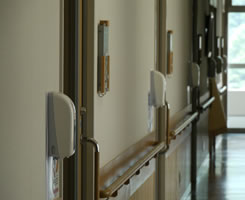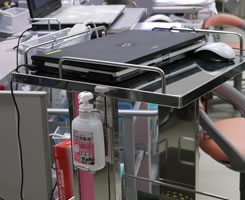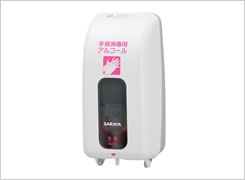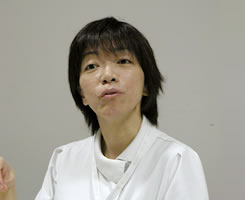Hospital-wide efforts toward Thorough Hand Hygiene

Kobe Rosai Hospital
-
Address:4-1-23, Kagoikedori, Chuo-ku, Kobe city, Hyogo, Japan
-
Number of beds:360
-
Total number of staff:452
-
Number of surgeries:3,141 (April 2010 to March 2011)
-
Website:https://www.kobeh.johas.go.jp/
※Saraya Co., Ltd.'s privacy policy does not apply to linked external websites.
Please refer to the privacy policy posted on the site.
Highlighted Products

Sensor activated dispenser
UD-8600
Interviewees

Ms. Chifumi Suzuki
Background
Steps taken to introduce UD-8600
- What led you to consider UD-8600?
|
Ms. Suzuki, Chief Nurse |
Prior to introducing UD-8600, we used manually operated dispensers, for their sophisticated appearance and ability to retain the chemical hygienically. However, after many years of use, the levers started to become worn, and our link nurse indicated hygiene and cross-contamination concerns. We asked the nursing aides to clean the levers frequently, but the stains were tough and the cleaning was time consuming. In addition, manually operated dispensers did not suit the elderly with less strength in their hands, patients with hand injuries and staff with disabilities in their hands, so we began considering a sensor activated dispenser. | ||
- Were there any worries in changing a familiar dispenser?
We had used the manually operated dispensers for about seven years. We were concerned about the evaluation on site for transferring to the sensor operated dispensers. In fact, when we initially introduced UD-8600, because people were used to a manually operated dispenser, they tended to place their hands too close for the sensors to detect. However, everyone eventually got used to the new dispensers.
After the introduction of UD-8600
- How did you familiarise your staff with UD-8600 and its usage?
The designated chemical for UD-8600 is disposable and easy to set, but we did have a briefing session with the chief nurses on how to install the refill cartridge. After the briefing, we received several more inquiries on how to install the refill cartridge, so we explained it again, and we printed the steps to its use, with photos and points to check, in our internal magazine.
- Where did you install UD-8600?
And how do you enforce hand hygiene where you cannot install UD-8600?
UD-8600 is installed at the entrance to every patient's room, which total about 130. It senses the hands easily and dispenses hand disinfectant, so patients' families use it too.
We cannot install a dispenser on trolleys where nurses put their laptop computer, so we place a bottle of hand disinfectant there instead. In addition, all nurses carry a 40ml bottle of hand disinfectant with them so they can carry out hand hygiene where dispensers are not installed. We are currently considering installing UD-8600 in the outpatient clinic as well.
 |
 |
||
| UD-8600 is installed at the entrance to every patient's room. | Trolley with laptop has a bottle of hand disinfectant attached to encourage hand hygiene. |
- How do you enforce hand hygiene training?
We have four to five ICT training sessions per year, and at each session, we have a section called 'Let's talk about future hand-washing', which focuses on hand hygiene. In this section, we have activities where attendees can visually learn the method and effects of hand hygiene, such as a hand wash check using a black light and a hand hygiene check that involves pressing a hand against a stamp plate with a bacterial cultivation medium to investigate the bacteria there. We have received positive feedback from attendees about the impact of visual effects in realising invisible microbes on their hands, helping them to reaffirm the importance of hand hygiene. Until last year, these training sessions were mostly for floor nurses, but nurses, medical technologists and doctors now attend the sessions too, so that staff in various categories can recognise the importance of hand hygiene. Some staff who were unaccustomed to hand disinfection were uncomfortable with hand disinfectants, but we managed to gain their understanding of the effects by comparing them to hand washing using soap and running water and seeing the outcomes on the hand stamp plate. We believe repeating training and having staff recognise the importance of the hand hygiene is essential.
- Did anything change after implementing UD-8600?
It appears that the usage of hand disinfectants has increased, although this may be due to the spread of a new strain of influenza. We use more cartridges than before. Also, the chemical cartridge for our manual dispensers was 800ml, whereas UD-8600 is 600ml, which allows us to use it all before the expiration date. In addition, because UD-8600 is thin and does not stick out from the walls, the corridor feels more orderly and wider.
 |
||
| The cartridge has an area to record the first day of use, which shows in the window of the dispensers, along with the remaining chemical. |
NEXT STEP
- What is your next challenge on future hand hygiene and infection control?
We conduct hand hygiene more often now, but it is important to familiarise and implement the critical moments of hand hygiene rather than frequency. WHO guidelines suggest five specific moments for hand hygiene in patient care, so we will base our training on these recommendations so our staff can implement hand hygiene at appropriate moments.
